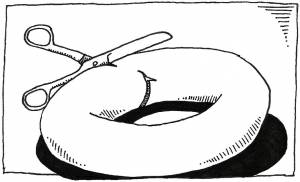Research
- Keywords: unfolding, cutting, tilling, topology, geometry, expert knowledge modelization.
- Applicative contexts: medical imaging, computer graphics, 3D printing, visual impaired people, geomatic.
During my PhD thesis thesis in 2006-2009, I focused on questions of cutting and tiling surfaces, integrating topological, geometrical and combinatorial constraints on the tiles. During these years, I designed algorithms using edge-based paths. I explored various applications, from medical imaging to computer graphics.
During my post-doc, I worked with the IMATI members on tiling/segmentation methods on surfaces, mainly using scalar functions and algorithms using piecewise-linear paths. I was also interested on working with semantic descriptors and/or expert knowledge to work on automatic labelling and/or classification.
Since September 2011, I am associate professor at ISIT. I joint first the ALCoV team, and I was focusing my work on medical imaging contexts, especially on pre-operative images like MRI, with the aim to extract surfaces from the voxel description, integrating expert knowledge, topological and geometrical constraints.
I am now of the thème DSI, Axe MAAD of LIMOS (UMR 6158), working on geometry processing, and I am working on the generation of tactile maps for visually impaired people.
Funded projects
ANR PRCE ACTIVmap (jan 2020, dec 2023)
- Funding: ANR
- Web site: activmap.limos.fr
I am the project coordinator of ACTIVmap.
SMART-eDOL (2019)
- Funding: APPEL À PROJETS CNRS / INSERM « DÉFI SANTÉ NUMÉRIQUE », 15k€
- Partners: UMR INSERM 1107 (NEURO-DOL). LIMOS is working on data warehouse, and data processing
HACCEScol (jan. 2019, dec. 2021)
- Funding: MSH, 15k€
- Partner: a multidisciplinary project (computer science, geography, law) that addresses the issue of accessibility of the school environment. LIMOS appears on the OSM part and description of the accessibility infrastructure.
- Web site: https://compas.limos.fr/HACCEScol/
I am the project coordinator of HACCEScol.
SAM-3D (sept. 2016 - aug. 2017)
- Funding: Bourse innovation transfert région Auvergne, 27k€
- Partner: Polymagine
- Topic: Semantic segmentation by expert guided learning of 3D meshes.
I was the project coordinator of SAM-3D.
3DCI (FUI, call for project 14)
The aim of the 3DCI project (FUI AAP14) consists in developping an original and innovative system for default detection during the inspection phase of electronic components of electronic board manufacturing.
In the 3DCI project, I was involved with ISIT laboratory to design new segmentation methods driven by expert knowledge and using abstract descriptions (such as graphs). The two application contexts are the present project and the medical imaging segmentation.
Read more on ISIT website: 3DCI
See also related projects:
Students and collaborators
PhD students:
- Gauthier Fillières-Riveau (co-supervised by Vincent Barra and Guillaume Touya, started on November 2017
Post-doctoral fellows:
- Saleh Modaddegh: April 2013 - March 2014
- Thomas Dietenbeck: December 2013 - August 2014
- Ahlem Othmani: September 2014 - August 2014
- Fakhri Torkhani: December 2014 - November 2015
- Coralie Bernay-Angeletti: October 2016 - September 2017
Engineers:
- Arash Akbarinia: September 2013 - August 2014
Publications
See all my publications, or browse the following subpages.
Topics
Research fields
 Algorithmic geometry
Algorithmic geometry
Keywords: mesh, tiling, cutting, topological and geometrical constraints, algorithms.
Abstract: algorithmic geometry and topology provide a large number of abstract objects and algorithms to manipulate manifolds (surfaces, volumic objects), to extract information and/or modify it under several constraints.
Applicative contexts
 Tactile maps
Tactile maps
Keywords: generalization, graph simplification, GIS, data rendering
Abstract: tactile maps for blind people are usually handmade, in order to address specific needs. In this work, I'm interested in automatic generation of these maps, using the OpenStreetMap database.
 Semantic
Semantic
Keywords: semantic, expert knowledge, labelling, segmentation.
Abstract: using semantic to drive data manipulation is an efficient way to integrate expert knowledge into the process. Ontologies are a useful and efficient way to describe semantic.
 Computer graphics
Computer graphics
Keywords: charts decomposition, parameterization, tiling.
Abstract: Integrating geometrical and topological constraints in computer graphics field is an interesting way to solve several questions, e.g. obtaining a satisfying cutting of a surface in order to perform in an efficient way a conformal parameterization. I am also interested in adapting the theoretical algorithms in order to offer interactive adjustments to the infographist.
 Medical imaging
Medical imaging
Keywords: MRI, segmentation, mesh reconstruction.
Abstract: pre and post-operative images like MRI can be modelized as voxel matrices, and a large number of algorithms from discrete geometry can be applied. Extracting a surface from such a description is also an interesting way to modelize the observed anatomical objects (organs, tissues, etc.) and facilitate the usage of geometrical and topological tools. I mainly worked on this approach, generating surfaces from the voxel description, then modifying the surface by integrating expert knowledge, related with geometry or topology, or extracting information to measure properties.
 Computer vision
Computer vision
Keywords: shape estimation, point clouds.
Abstract: computer vision field is mainly motivated by linear or quasi-linear approaches of image processing, for example for shape estimation from image sequences. But it also need to introduce original point cloud or mesh processing to extract geometric properties.
 Procedural textures
Procedural textures
Keywords: multifractal textures, texture generation, mesh processing.
Abstract: procedural textures permit to generate from a few number of parameter an infinite set of textures.
